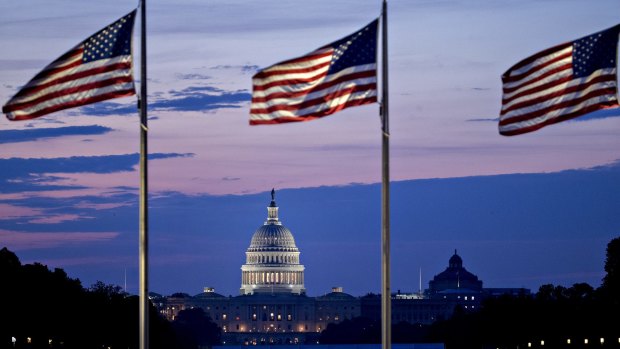A cut to the United States government’s credit rating is predicted to weigh on investor sentiment, as markets continue to debate the risk of a US economic slump caused by the rapid rise in interest rates.
The local sharemarket and the Australian dollar both slumped on Wednesday after Fitch Ratings lowered the US government’s credit rating by one notch from AAA to AA+, saying it expected public debt to grow, while noting repeated stand-offs over the nation’s debt ceiling.

Fitch downgraded its credit rating for the US government, pointing to repeated stand-offs over the debt ceiling.Credit: Bloomberg
In downgrading US Treasury bonds, which are regarded as the ultimate “risk-free” asset, Fitch is following the lead of Standard & Poor’s, which downgraded the US in 2011.
While US Treasury Secretary Janet Yellen slammed the move as “arbitrary” and some experts said the downgrade would have limited real-world implications, others argued it would make investors more nervous at a time of economic uncertainty.
The ASX 200 fell 1.3 per cent and the Australian dollar, which tends to weaken when investors are more wary, dipped below 66 US¢. Australia remains one of a handful of countries that have AAA credit ratings from S&P.
Perpetual’s head of investment strategy, multi-asset, Matt Sherwood, said the US rating downgrade had important implications for global markets and highlighted the need for the US government to repair its finances.
“I think a downgrade of the government debt of the US, which forms the basis of the global cost of capital, is very significant,” Sherwood said.
Sherwood added that high debt remains a challenge for the US economy even while it was in full employment, and he predicted the downgrade would drag on “risk” markets such as shares.
“I think this is significant, and it will lead to a lower US dollar, currency appreciation pretty much around the world – and that’s obviously going to weigh on global risk markets,” Sherwood said.
AMP deputy chief economist Diana Mousina said the Fitch downgrade was not a complete shock, but it could add to concerns about the risk of US recession caused by the rapid rise in interest rates. She said there was also a risk US shares – which have surged this year, driven by tech stocks – had rallied too far.
“There’s an increasing risk that shares have gone too far and there’s a pull-back, and the credit rating downgrade could add to further nervousness,” Mousina said.
Mousina said that, for most countries, a credit rating downgrade would lead to higher borrowing costs for the government, which could feed into higher corporate debt costs as well. The US is different because it issues the world’s reserve currency and its bonds tend to be sought-after in times of stress, she said.
“Even though it’s got a lower credit rating, it’s still liquid, and it can still issue bonds. There’s no risk that the government cannot be funded,” Mousina said.
Currency strategist at foreign exchange provider Corpay Peter Dragicevich said the downgrade had probably compounded pressure on the Aussie dollar after Tuesday’s Reserve Bank decision to keep the cash rate on hold.
But he said the move would not change investors’ attitudes to holding US government bonds, as mandates that required some investors to hold AAA assets were loosened after S&P’s downgrade in 2011.
”It’s still the reserve currency; it’s still the most liquid and deepest bond market there is – that’s not going to change,” Dragicevich said.
GSFM investment strategist Stephen Miller did not think the downgrade would have a major bearing on markets but he said it was a reminder that politicians were not working effectively, and this idea was relevant outside the US as well.
“The big message is that the political class is letting down their constituencies,” he said.
The Market Recap newsletter is a wrap of the day’s trading. Get it each weekday afternoon.